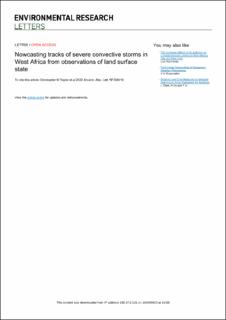| dc.contributor.author | Taylor, Christopher M | |
| dc.contributor.author | Klein, Cornelia | |
| dc.contributor.author | Dione, Cheikh | |
| dc.contributor.author | Parker, Douglas John | |
| dc.contributor.author | Marsham, John | |
| dc.contributor.author | Abdoulahat Diop, Cheikh | |
| dc.contributor.author | Fletcher, Jennifer | |
| dc.contributor.author | Saidou Chaibou, Abdoul Aziz | |
| dc.contributor.author | Nafissa, Dignon Bertin | |
| dc.contributor.author | Semeena, Valiyaveetil Shamsudheen | |
| dc.contributor.author | Cole, Steven J | |
| dc.contributor.author | Anderson, Seonaid R | |
| dc.date.accessioned | 2023-09-20T07:38:45Z | |
| dc.date.available | 2023-09-20T07:38:45Z | |
| dc.date.created | 2022-06-01T11:43:41Z | |
| dc.date.issued | 2022 | |
| dc.identifier.citation | Environmental Research Letters. 2022, 17 (3), 1-10. | en_US |
| dc.identifier.issn | 1748-9326 | |
| dc.identifier.uri | https://hdl.handle.net/11250/3090662 | |
| dc.description.abstract | In tropical convective climates, where numerical weather prediction of rainfall has high uncertainty, nowcasting provides essential alerts of extreme events several hours ahead. In principle, short-term prediction of intense convective storms could benefit from knowledge of the slowly evolving land surface state in regions where soil moisture controls surface fluxes. Here we explore how near-real time (NRT) satellite observations of the land surface and convective clouds can be combined to aid early warning of severe weather in the Sahel on time scales of up to 12 h. Using land surface temperature (LST) as a proxy for soil moisture deficit, we characterise the state of the surface energy balance in NRT. We identify the most convectively active parts of mesoscale convective systems (MCSs) from spatial filtering of cloud-top temperature imagery. We find that predictive skill provided by LST data is maximised early in the rainy season, when soils are drier and vegetation less developed. Land-based skill in predicting intense convection extends well beyond the afternoon, with strong positive correlations between daytime LST and MCS activity persisting as far as the following morning in more arid conditions. For a Forecasting Testbed event during September 2021, we developed a simple technique to translate LST data into NRT maps quantifying the likelihood of convection based solely on land state. We used these maps in combination with convective features to nowcast the tracks of existing MCSs, and predict likely new initiation locations. This is the first time to our knowledge that nowcasting tools based principally on land observations have been developed. The strong sensitivity of Sahelian MCSs to soil moisture, in combination with MCS life times of typically 6–18 h, opens up the opportunity for nowcasting of hazardous weather well beyond what is possible from atmospheric observations alone, and could be applied elsewhere in the semi-arid tropics. | en_US |
| dc.language.iso | eng | en_US |
| dc.rights | Navngivelse 4.0 Internasjonal | * |
| dc.rights.uri | http://creativecommons.org/licenses/by/4.0/deed.no | * |
| dc.title | Nowcasting tracks of severe convective storms in West Africa from observations of land surface state | en_US |
| dc.title.alternative | Nowcasting tracks of severe convective storms in West Africa from observations of land surface state | en_US |
| dc.type | Peer reviewed | en_US |
| dc.type | Journal article | en_US |
| dc.rights.holder | © 2022 The Author(s) | en_US |
| dc.description.version | publishedVersion | en_US |
| cristin.ispublished | true | |
| cristin.fulltext | original | |
| cristin.qualitycode | 2 | |
| dc.identifier.doi | 10.1088/1748-9326/ac536d | |
| dc.identifier.cristin | 2028699 | |
| dc.source.journal | Environmental Research Letters | en_US |
| dc.source.volume | 17 | en_US |
| dc.source.issue | 3 | en_US |
| dc.source.pagenumber | 1-10 | en_US |

